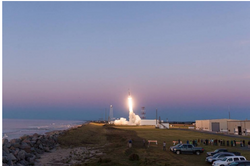
A NASA Sounding Rocket Launch from Wallops Island in 2014, similar to our scheduled launch on June 24, 2021.
Media:

“Cubes in Space™, a program by idoodlEdu inc., is the only global competition offered at no cost for students 11-18 years of age to design and propose experiments to launch into space on a NASA sounding rocket and zero-pressure scientific balloon.
Cubes in Space is offered in collaboration with NASA’s Goddard Space Flight Center – Wallops Flight Facility, NASA’s Langley Research Center and the Colorado Space Grant Consortium.”
How Vibration, G-forces, and Spin Affect the Durability of Dye-Sensitized Solar Cells
Hypothesis:
If a dye-sensitized solar cell is exposed to the vibration, g-forces and spin of a NASA Sounding Rocket, we predict the Titanium Dioxide and Anthocyanin layer will suffer physical deterioration in the form of microscopic fractures, rendering fully assembled panels ineffective for space travel.
Human space exploration and non Earth-based planetary settlements are becoming a reality for the Artemis generation. NASA and private space contractors are busy creating and testing designs for both Lunar and Martian habitats and support systems. In order to successfully establish viable and sustainable outposts on any planet or moon, we will have to make use of available local resources. To this end, we cannot pollute or contaminate any potential resources as we have done on Earth.
Solar panels are one form of sustainable energy production that can be used on other worlds as well as during space transit. However, solar panels have the unfortunate side effect of using toxic materials while being manufactured. What if natural materials could be used instead of these toxic materials? Better yet, what if we could grow the materials used to make solar panels? On a planet like Mars, this would greatly reduce the costs involved with shipping supplies from the Earth, and go a long way in making Mars self-sustainable. Another benefit of sustainable solar cells is that some of the supplies can be grown while in space on transit trips.
At the moment, dye-sensitized solar panels have a production span of just a few months. However, with development and further experimentation we hope to expand this timeframe. That said, even with the few months of production we currently have, these dye-sensitized solar panels can be used immediately as back up panels to produce energy while new ones are being produced or installed. The benefits of dye-sensitized solar panels are both immediate and long term. In order to further investigate their viability for space, it is necessary to understand whether or not they can be launched pre-made into space or if they should be assembled post-launch.
Dye-sensitized solar cells rely on multiple layers of materials including a layer of titanium dioxide and raspberry juice extract wedged between two tin-oxide coated glass pieces. This natural solar cell mimics the photosynthesis process by replacing chlorophyll with a light-absorbing dye sourced from a raspberry, anthocyanin. As with photosynthesis, light waves excite molecules to a higher energetic state and the energy produced is collected by a structure of electrolytes (the nanocrystalline titanium dioxide paste) and catalysts (the anthocyanin), replicating the structure of a leaf in photosynthesis.
Due to the layered nature of the cell, specifically the anthocyanin/titanium dioxide paste, concerns remain about the launch process in terms of the viability of fully assembled solar cells to be used in space. The exposure to high vibrations, g-forces, and spin that occurs during launch may affect the surface composition of the layered paste and therefore its productivity once exposed to light. By carefully examining the solar cells using both a compound microscope and a scanning electron microscope before and after launch, we hope to examine and document the surface structure to identify any abnormalities or surface cracks that could interrupt the electron transfer needed to produce energy. We will also use a digital multimeter under a designated and controlled light source to measure productivity of the solar cell before and after the launch.
Dye-sensitized solar cells are an exciting new, sustainable field for natural, non toxic energy production to be used in space exploration and habitation. We hope to use Cubes in Space rocket launch opportunity to study and determine whether these cells can be assembled prior to launch or if they must be assembled post launch.
 |  |  |  |
|---|---|---|---|
 |  |  |  |


